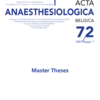Dural Puncture Epidural: to puncture or not to puncture?
Dural puncture; epidural; labour; analgesia
Published online: Apr 21 2022
Abstract
Objective: The aim of this systematic review is to compare the evidence derived from randomised controlled trials (RCT) regarding the use of dural puncture epidural (DPE) versus conventional epidural analgesia (EA) or combined spinal epidural analgesia (CSE) for labouring patients.
Background: DPE is a modification of the conventional epidural technique which implicates the intended puncture of the dura mater with a spinal needle but without administering drugs intrathecally. The potential benefits and risks of this technique remain debated.
Methods: A systematic literature search, retrieved from PubMed, Cochrane Library, Science direct and Web of Science, was performed to identify RCT comparing DPE with epidural or CSE analgesia.
Results: Seven RCTs were identified for final analysis. Their collective results showed no significant difference in quality of analgesia, catheter reliability and adverse outcomes.
Conclusion: Although a trend towards better analgesic outcome and a more favourable risk- benefit profile was observed, the significance of current evidence regarding DPE in labouring patients remains unclear. Further research is warranted and should focus on elucidating the optimal spinal needle size as well as the elements governing the flux of drugs over the meninges in the presence of a dural hole.
